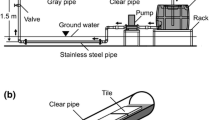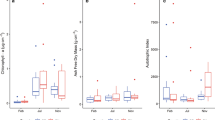Abstract
Small streams are ecosystems mainly controlled by physical factors. Minor differences in these factors can affect periphyton, which are key functional communities in these ecosystems. Eight different environmental conditions combining two types of current, two flow velocities and two light intensities were produced and controlled in artificial channels. Their impact on young and mature periphyton was investigated during a 6-week exposure period. The two different levels of light intensity produced early effects on the algal community. In young periphyton, the lower level of light intensity enhanced the number of algal cells, and this community appeared to be significantly structured by light. As the periphyton matured, the effects of physical factors became more marked. At this later stage, both the bacterial and algal communities began to be affected. Both function (primary production) and structure began to respond to differences in light and in flow velocity. Small differences in low-level environmental factors, such as light and flow, had an effect both on the structure of periphyton and its functional capacities. Keeping in mind the close link between diversity and function in microbial communities, periphyton confronted to various environmental stresses (pollution, flooding) in the field may behave differently due to minor differences in physical factors.



Similar content being viewed by others
References
Amann R, Binder B, Olson R, Chisholm S, Devereux R, Stahl D (1990) Combination of 16S rRNA targeted oligonucleotide probes with flow-cytometry for analyzing mixed microbial populations. Appl Environ Microbiol 56:1919–1925
Battin TJ, Kaplan LA, Newbold JD, Hansen CME (2003a) Contributions of microbial biofilms to ecosystem processes in stream mesocosms. Nature 426:439–442
Battin TJ, Kaplan LA, Newbold JD, Cheng XH, Hansen CME (2003b) Effects of current velocity on the nascent architecture of stream microbial biofilms. Appl Environ Microbiol 69:5443–5452
Besemer K, Singer G, Limberger R, Chlup AK, Hochedlinger G, Hodl I, Baranyi C, Battin TJ (2007) Biophysical controls on community succession in stream biofilms. Appl Environ Microbiol 73:4966–4974
Biggs BJF (1996) Hydraulic habitat of plants in streams. Regul Rivers Res Manag 12:131–144
Biggs BJF (2000) New Zealand periphyton guidelines: detecting, monitoring and managing the enrichment of streams, vol A. Background and guidelines. Ministry for the Environment, Wellington, 151 pp
Biggs BJF, Hickey CW (1994) Periphyton responses to a hydraulic-gradient in a regulated river in New-Zealand. Freshw Biol 32:49–55
Biggs BJF, Stokseth S (1996) Hydraulic habitat suitability for periphyton in rivers. Regul Rivers Res Manag 12:251–261
Biggs BJF, Thomsen HA (1995) Disturbance of stream periphyton by perturbations in shear-stress—time to structural failure and differences in community resistance. J Phycol 31:233–241
Biggs BJF, Goring DG, Nikora VI (1998) Subsidy and stress responses of stream periphyton to gradients in water velocity as a function of community growth form. J Phycol 34:598–607
Bouletreau S, Garabetian F, Sauvage S, Sanchez-Perez JM (2006) Assessing the importance of a self-generated detachment process in river biofilm models. Freshw Biol 51:901–912
Chróst RJ (1991) Environmental control of the synthesis and activity of aquatic microbial ectoenzymes. In: Chróst RJ (ed) Microbial enzymes in aquatic environments. Springer, New York, pp 29–59
Costerton JW, Lewandowski Z, Caldwell DE, Korber DR, Lappinscott HM (1995) Microbial biofilms. Annu Rev Microbiol 49:711–745
Davies-Colley RJ, Quinn JM (1998) Stream lighting in five regions of North Island, New Zealand: control by channel size and riparian vegetation. NZ J Mar Freshw Res 32:591–605
DeLorenzo ME, Scott GI, Ross PE (1999) Effects of the agricultural pesticides atrazine, deethylatrazine, endosulfan, and chlorpyrifos on an estuarine microbial food web. Environ Toxicol Chem 18:2824–2835
Dodds WK (1989) Photosynthesis of two morphologies of Nostoc parmelioides (Cyanobacteria) as related to current velocities and diffusion patterns. J Phycol 25:258–262
Dodds WK, Hutson RE, Eichem AC, Evans MA, Gudder DA, Fritz KM, Gray L (1996) The relationship of floods, drying, how and light to primary production and producer biomass in a prairie stream. Hydrobiologia 333:151–159
Dorigo U, Leboulanger C, Berard A, Bouchez A, Humbert JF, Monuelle B (2007) Lotic biofilm community structure and pesticide tolerance along a contamination gradient in a vineyard area. Aquat Microb Ecol 50:91–102
Duhamel S, Jacquet S (2006) Flow cytometric analysis of bacteria- and virus-like particles in lake sediments. J Microbiol Methods 64:316–332
Francoeur SN, Biggs BJF (2006) Short-term effects of elevated velocity and sediment abrasion on benthic algal communities. Hydrobiologia 561:59–69
Ghosh M, Gaur JP (1998) Current velocity and the establishment of stream algal periphyton communities. Aquat Bot 60:1–10
Guasch H, Sabater S (1995) Seasonal-variations in photosynthesis-irradiance responses by biofilms in Mediterranean streams. J Phycol 31:727–735
Guasch H, Sabater S (1998) Light history influences the sensitivity to atrazine in periphytic algae. J Phycol 34:233–241
Guasch H, Munoz I, Roses N, Sabater S (1997) Changes in atrazine toxicity throughout succession of stream periphyton communities. J Appl Phycol 9:137–146
Gustina GW, Hoffmann JP (2000) Periphyton dynamics in a subalpine mountain stream during winter. Arct Antarct Alp Res 32:127–134
Hansson LA (1992) The role of food-chain composition and nutrient availability in shaping algal biomass development. Ecology 73:241–247
Hill W (1996) Factors affecting benthic algae. Effects of light. In: Stevenson RJ, Bothwell ML, Lowe RL (eds) Algal ecology, freshwater benthic ecosystems. Academic Press, San Diego, pp 121–148
Hillebrand H, Sommer U (2000) Diversity of benthic microalgae in response to colonization time and eutrophication. Aquat Bot 67:221–236
Lock MA (1993) Attached microbial communities in river. In: Ford TE (ed) Aquatic microbiology. Blackwell Scientific, Oxford, pp 113–138
Lyautey E, Jackson CR, Cayrou J, Rols JL, Garabetian F (2005) Bacterial community succession in natural river biofilm assemblages. Microb Ecol 50:589–601
MacCabe SK, Cyr H (2006) Environmental variability influences the structure of benthic algal communities in an oligotrophic lake. Oikos 115:197–206
MacLeod NA, Barton DR (1998) Effects of light intensity, water velocity and species composition on carbon and nitrogen stable isotope ratios in periphyton. Can J Fish Aquat Sci 55:1919–1925
Montuelle B (2006) Evaluation de gains biologique et écologique associés à une réduction d’intrants polluants en milieu aquatique. Rapport final CPER 2003–2006, Région Rhône Alpes, 55 pp
Mosisch TD, Bunn SE, Davies PM (2001) The relative importance of shading and nutrients on algal production in subtropical streams. Freshw Biol 46:1269–1278
Munoz I, Real M, Guasch H, Navarro E, Sabater S (2001) Effects of atrazine on periphyton under grazing pressure. Aquat Toxicol 55:239–249
Muyzer G, Smalla K (1998) Application of denaturing gradient gel electrophoresis (DGGE) and temperature gradient gel electrophoresis (TGGE) in microbial ecology. Antonie Van Leeuwenhoek Int J Gen Mol Microbiol 73:127–141
Peterson CG (1996) Mechanisms of lotic microalgal colonization following space-clearing disturbances acting at different spatial scales. Oikos 77:417–435
Pusch M, Fiebig D, Brettar I, Eisenmann H, Ellis BK, Kaplan LA, Lock MA, Naegeli MW, Traunspurger W (1998) The role of micro-organisms in the ecological connectivity of running waters. Freshw Biol 40:453–495
Roberts S, Sabater S, Beardall J (2004) Benthic microalgal colonization in streams of differing riparian cover and light availability. J Phycol 40:1004–1012
Romani AM, Sabater S (1999) Effect of primary producers on the heterotrophic metabolism of a stream biofilm. Freshw Biol 41:729–736
Romani AM, Giorgi A, Acuna V, Sabater S (2004) The influence of substratum type and nutrient supply on biofilm organic matter utilization in streams. Limnol Oceanogr 49:1713–1721
Sabater S, Gregory SV, Sedell JR (1998) Community dynamics and metabolism of benthic algae colonizing wood and rock substrata in forest stream. J Phycol 34:561–567
Schauer M, Balague V, Pedros-Alio C, Massana R (2003) Seasonal changes in the taxonomic composition of bacterioplankton in a coastal oligotrophic system. Aquat Microb Ecol 31:163–174
Schmitt-Jansen M, Altenburger R (2005) Predicting and observing responses of algal communities to photosystem II-herbicide exposure using pollution-induced community tolerance and species-sensitivity distributions. Environ Toxicol Chem 24:304–312
Sekar R, Nair KVK, Rao VNR, Venugopalan VP (2002) Nutrient dynamics and successional changes in a lentic freshwater biofilm. Freshw Biol 47:1893–1907
Singer G, Besemer K, Hödl I, Chlup AK, Hochedingler G, Stadler P, Battin TJ (2006) Microcosm design and evaluation to study stream microbial biofilms. Limnol Oceanogr Methods 4:436–447
Sogin L, Gunderson GH (1987) Structural diversity of eukaryotic small subunit ribosoma RNAs. Ann N Y Acad Sci 503:125–139
Steinman AD, McIntire CD (1987) Effects of irradiance on the community structure and biomass of algal assemblages in laboratory streams. Can J Fish Aquat Sci 44:1640–1648
Stevenson RJ, Peterson CG (1991) Emigration and immigration can be important determinance of benthic diatom assemblages in stream. Freshw Biol 26:279–294
Uehlinger U (1991) Spatial and temporal variability of the periphyton biomass in a Prealpine River (Necker, Switzerland). Arch Hydrobiol 123:219–237
Van der Grinten E (2004) Dynamic species interactions in phototrophic biofilms. PhD thesis, Department of Aquatic Ecology and Ecotoxicology, FNWI, Université d’Amsterdam, 149 pp
Vaulot D (1989) CYTOPC: processing software for flow cytometric data. Signal Noise 2:8
Wellnitz T, Rader RB (2003) Mechanisms influencing community composition and succession in mountain stream periphyton: interactions between scouring history, grazing, and irradiance. J North Am Benthol Soc 22:528–541
Woodruff SL, House WA, Callow ME, Leadbeater BSC (1999) The effects of biofilms on chemical processes in surficial sediments. Freshw Biol 41:73–89
Acknowledgments
The authors wish to thank J.C. Druart, S. Jacquet, B. Le Berre, B. Motte and P. Perney for their help in laboratory. We also thank two anonymous reviewers for their relevant comments for improving the manuscript. The project received funding from the national program ECOGER (PAPIER 2006–2008 Program) and was included in a global study of the Ardières-Morcille watershed, LTER Zone Atelier du Bassin du Rhône. English text was edited by Monika Ghosh.
Author information
Authors and Affiliations
Corresponding author
Rights and permissions
About this article
Cite this article
Villeneuve, A., Montuelle, B. & Bouchez, A. Influence of slight differences in environmental conditions (light, hydrodynamics) on the structure and function of periphyton. Aquat. Sci. 72, 33–44 (2010). https://doi.org/10.1007/s00027-009-0108-0
Received:
Accepted:
Published:
Issue Date:
DOI: https://doi.org/10.1007/s00027-009-0108-0




